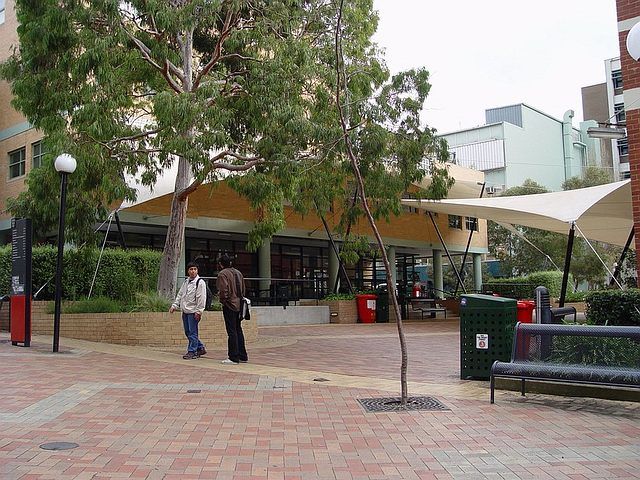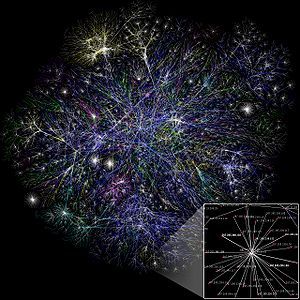Vocabulary
Audio
 |
| By SimonEast. GNU Free Documentation License |
The Internet is a global system of interconnected computer networks that use the standard Internet Protocol Suite (TCP/IP) to serve billions of users worldwide. It is a network of networks that consists of millions of private and public, academic, business, and government networks of local to global scope that are linked by a broad array of electronic and optical networking technologies. The Internet carries a vast array of information resources and services, most notably the inter-linked hypertext documents of the World Wide Web (WWW) and the infrastructure to support electronic mail.
Most traditional communications media, such as telephone and television services, are reshaped or redefined using the technologies of the Internet, giving rise to services such as Voice over Internet Protocol (VoIP). The Internet has enabled or accelerated the creation of new forms of human interactions through instant messaging, Internet forums, and social networking sites.
 |
| By Matt Britt. C. Commons |
The origins of the Internet reach back to the 1960s when the United States funded research projects of its military agencies to build robust, fault-tolerant and distributed computer networks. This research and a period of civilian funding of a new U.S. backbone by the National Science Foundation spawned worldwide participation in the development of new networking technologies and led to the commercialization of an international network in the mid 1990s, and resulted in the following popularization of countless applications in virtually every aspect of modern human life. As of 2009, an estimated quarter of Earth's population uses the services of the Internet, which turns it into the most useful and quickly way of communicating and getting information.
The Internet has no centralized governance in either technological implementation or policies for access and usage; each constituent network sets its own standards. Only the overreaching definitions of the two principal name spaces in the Internet, the Internet Protocol address space and the Domain Name System, are directed by a maintainer organization, the Internet Corporation for Assigned Names and Numbers (ICANN). The technical underpinning and standardization of the core protocols is an activity of the Internet Engineering Task Force (IETF), a non-profit organization of loosely-affiliated international participants that anyone may associate with by contributing technical expertise.
1 Adapted from Wikipedia.org
1. According to the text, does the Internet consist of the hypertext documents of the WWW and the infrastructure to support electronic mail?
2. According to the text, has the Internet changed human interactions?
3. Who governs the Internet?
Internet vocabulary is the very first computer basics that you should become familiar with. Vocabulary is the first phase to give you the knowledge to be able to communicate in English when you surf the net or look up any web pages that are only in English
It is
sometimes true that many of the ordinary mistakes made using computers have a
lot to do with their Internet vocabulary and not following instructions, which
sometimes are only in English.
Lets just
get started with some computer basic vocabulary; it is always advisable to get
familiar with the words used and their meanings.
| address bar | loop | ||
| @ (at) | password | ||
| backup | public domain |
||
| bandwidth | RAM, ROM |
||
| browser | save | ||
| bookmark | secure server | ||
| check the box | shopping cart | ||
| digital signature |
spam | ||
| dot com | store | ||
| download | toolbar | ||
| drop down list/menu | updated | ||
| FAQ | upload | ||
| firewall | user name | ||
| homepage | web page address | ||
| link | web site |
Write the translation for these words and expressions. If you need any help, try this link
1. A software or hardware that can help prevent hackers or malicious software (such as worms) from gaining access to your computer through a network or the Internet.
|
a. Firefighter
| |
|
b. Firewall
|
|
a. Bandwidth
| |
|
b. Backup
|
|
a. Bookmark
| |
|
b. Backup
|
|
a. Browser
| |
|
b. Modem
|
|
a. User name
| |
|
b. Password
|
|
a. Database
| |
|
b. Copyright
|
|
a. Download
| |
|
b. Update
|
|
a. Site
| |
|
b. Link
|